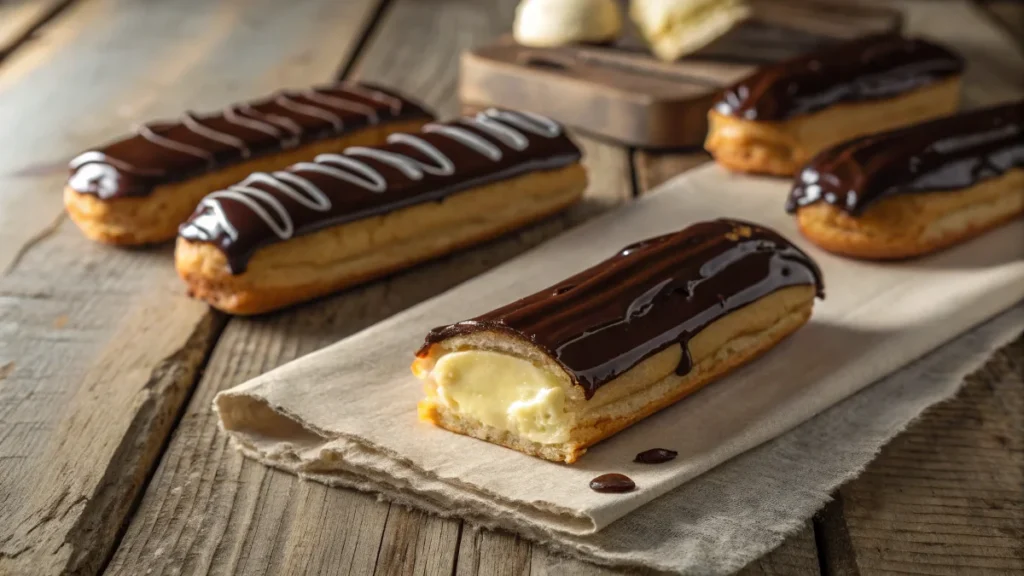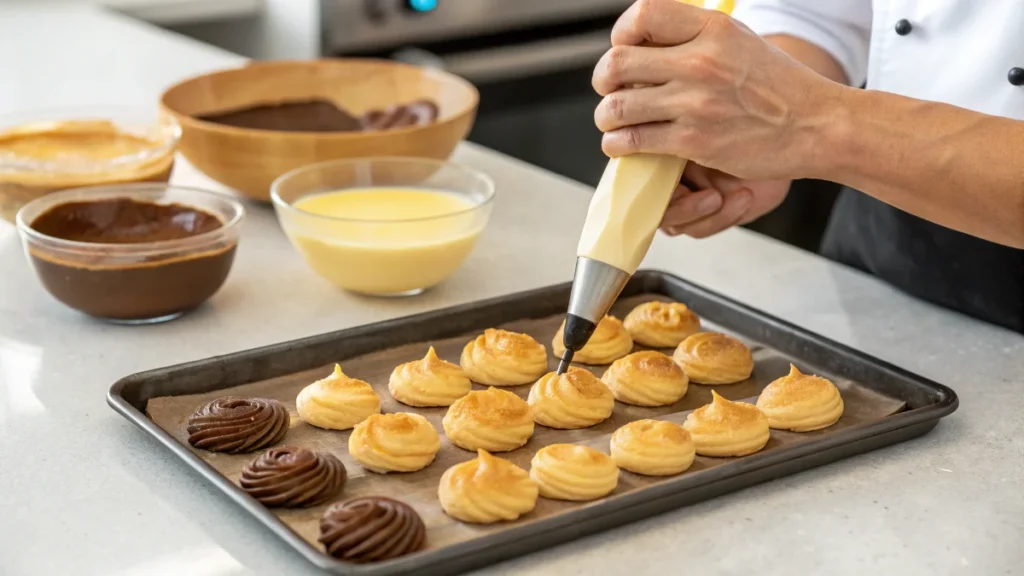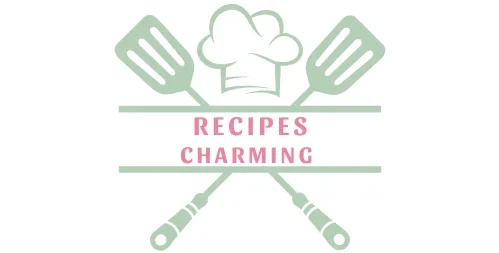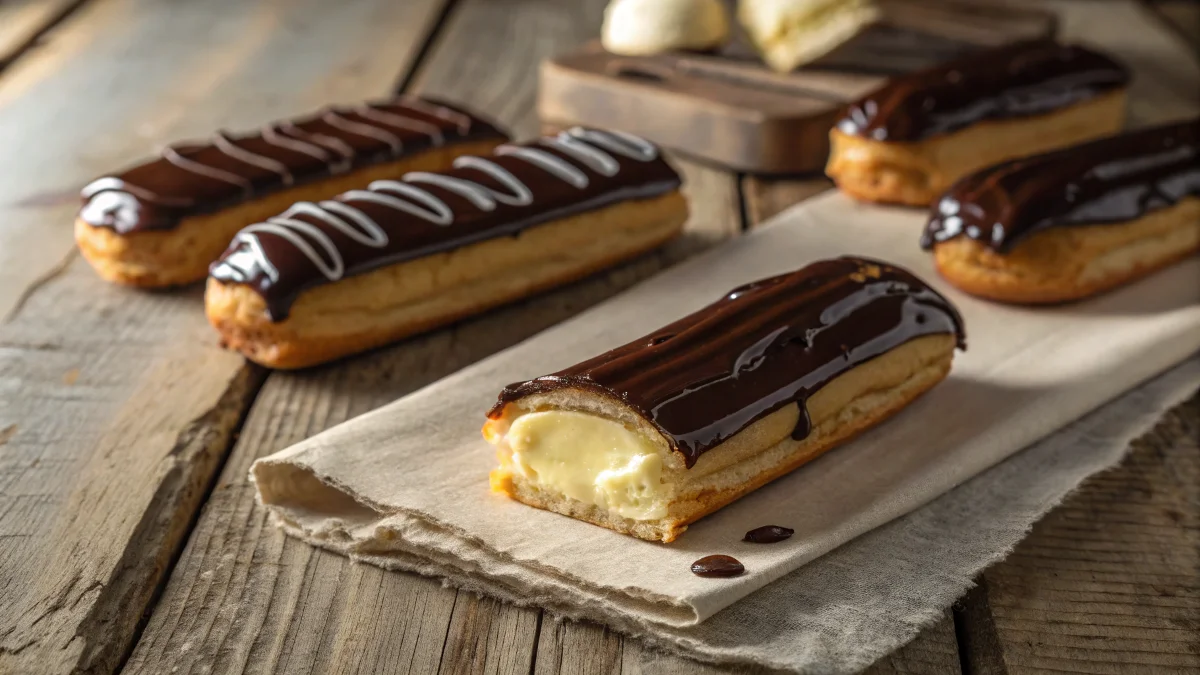The éclair, with its delicate choux pastry and creamy filling, is one of the world’s most iconic pastries. But why is it called éclair cake, and where does the name éclair, meaning “lightning” in French, come from? Some say the name reflects how quickly the pastry is eaten—so delicious that it disappears in a flash. Others suggest a deeper connection, perhaps tied to its shiny glaze, resembling a lightning strike.
Creating the perfect éclair requires precision, from light pastry to smooth, glossy icing. For tips and techniques, Eclair Icing and Baking Secrets: Everything You Need to Know About Eclairs offers valuable insights.
Whether it’s the name or its artistry, the éclair remains a masterpiece of French patisserie.

Table of Contents
The Meaning Behind the Word “Éclair”
The Literal Meaning: Lightning
In French, “éclair” literally means “lightning.” But why would a dessert share its name with a powerful natural phenomenon? The most common explanation is tied to the way éclairs are eaten. They are so delicious and tempting that they are often consumed “in a flash”, leaving nothing behind but the memory of their exquisite taste.
This interpretation is supported by French culinary lore, where desserts are often named with playful, metaphorical phrases. For example, other pastries like “petits fours” (meaning “small ovens”) or “madeleines” carry charmingly descriptive names.
A Shiny Connection?
Another theory connects the éclair’s name to its shiny glaze. The chocolate or icing that tops the pastry gleams under the light, reminiscent of a lightning flash. This interpretation emphasizes the visual appeal of the éclair, which is as much a feast for the eyes as it is for the palate.
A Name That Sticks
Regardless of its exact origin, the name “éclair” perfectly captures the dessert’s irresistible charm. It conveys a sense of excitement and indulgence, making it one of the most memorable names in the world of pastries. Today, the éclair’s name is universally recognized, symbolizing not just a dessert but an entire tradition of culinary excellence.
The Historical Origins of Éclairs
French Beginnings in the 19th Century
The éclair dates back to 19th-century France and is credited to Marie-Antoine Carême, the “King of Chefs.”
Carême perfected choux pastry, a simple dough of butter, water, flour, and eggs, which puffs beautifully when baked. This dough became the foundation for iconic desserts like cream puffs, profiteroles, and éclairs.
For more creative baking ideas, try Chocolate Chip Banana Bread Muffins, blending classic flavors with a fresh twist.
Carême’s innovations continue to inspire pastry lovers today.
The Original Name: Pain à la Duchesse
Initially, éclairs were known as “pain à la duchesse” (or “duchess bread”) and were considered a luxurious treat reserved for the elite. By the mid-19th century, they had become popular in French patisseries, where their name evolved to “éclair,” reflecting their growing status as a culinary lightning bolt.
The Spread of Éclairs Around the World
As French cuisine gained global influence, éclairs began appearing in bakeries across Europe, the United States, and beyond. Each region added its own twist, from varying fillings to creative toppings. Yet, the éclair’s core identity—a hollow pastry filled with rich cream and topped with glossy icing—remained unchanged.

Anatomy of an Éclair – What Makes It Special?
The Three Key Components
What sets an éclair apart from other desserts is its perfect balance of flavors and textures. Each éclair is a carefully crafted combination of three key components:
- Choux Pastry:
The base of the éclair is made from choux pastry, a unique dough that expands in the oven to create a hollow interior. The light, airy structure of the pastry is critical, as it provides the perfect vessel for creamy fillings. - Filling:
Traditional éclairs are filled with pastry cream, a custard-like mixture made with milk, eggs, sugar, and vanilla. Modern variations have expanded the repertoire to include whipped cream, chocolate mousse, or even fruit-flavored fillings. The filling adds richness and flavor, creating the “wow” factor in every bite. - Glaze:
The final touch is the glaze, often made from melted chocolate or sugar icing. A good glaze should be shiny and smooth, enhancing both the flavor and the visual appeal of the pastry.
A Bite of Perfection
The genius of the éclair lies in the way these components come together. The crisp yet tender shell contrasts beautifully with the silky filling, while the glaze adds a burst of sweetness. It’s a symphony of textures and flavors that feels indulgent yet balanced.
Why the Shape Matters
The éclair’s oblong shape also plays a role in its appeal. Unlike round pastries, the elongated form allows for an even distribution of filling, ensuring every bite delivers the perfect mix of pastry, cream, and glaze.
The Global Appeal of Éclairs
A Pastry for the World
While éclairs originated in France, their appeal has transcended borders. Today, you’ll find éclairs in bakeries and cafes worldwide, each region adding its own unique flair to this classic treat.
Regional Variations
- United States: In the U.S., éclairs are often larger and sweeter than their French counterparts. American versions may use pudding or whipped cream as fillings, catering to local tastes.
- Japan: In Japan, éclairs are infused with flavors like matcha (green tea) or yuzu (a citrus fruit), reflecting the country’s love for subtle, refined desserts.
- Italy: Italian éclairs often feature mascarpone or espresso fillings, offering a nod to the country’s coffee culture.
A Canvas for Creativity
Éclairs have become a canvas for pastry chefs, blending creativity with tradition. From vibrant glazes to exotic fillings, they now feature flavors like passion fruit, salted caramel, and raspberry rose. Gourmet shops, such as L’Éclair de Génie in Paris, have elevated the éclair to an art form, redefining its possibilities.
For a broader perspective on popular baked goods, explore What is the most popular muffin in the world? and discover how muffins captivate dessert lovers globally.
Modern éclairs show how tradition and innovation can create timeless culinary masterpieces.
Fun Facts and Lesser-Known Details About Éclairs
The World’s Longest Éclair
In 2014, French pastry chefs set a Guinness World Record by creating the world’s longest éclair, measuring over 500 feet. This monumental pastry showcased not just the skill of the chefs but also the universal love for éclairs.
Éclairs in Pop Culture
Éclairs have made their way into movies, books, and TV shows as symbols of indulgence and sophistication. Their appearance often conveys luxury, much like champagne or caviar.
A Dessert with Endless Possibilities
Did you know that éclairs aren’t always sweet? Some chefs have created savory éclairs, filled with ingredients like smoked salmon, cheese, or truffle mousse. These innovations highlight the pastry’s versatility and its ability to adapt to new culinary trends.
Éclairs for Special Occasions
In France, éclairs are often featured in celebrations, from birthdays to weddings. Their elegant appearance makes them a popular choice for dessert tables and high tea menus.
Part 6: How Éclairs Became a Culinary Art Form (Expanded: 450+ Words)
The Role of French Pastry Schools
French pastry schools, such as the world-renowned Le Cordon Bleu, have been instrumental in transforming éclairs into a culinary art form. These schools focus on perfecting techniques like crafting choux pastry, piping precise shapes, and achieving a flawless glaze. Students learn that making éclairs is not just about following a recipe—it’s about achieving consistency, balance, and creativity.
Creativity in Presentation
Over time, the éclair has become a blank canvas for pastry chefs to express their artistry. Gone are the days of only chocolate-topped éclairs. Today’s éclairs feature:
- Hand-painted decorations using edible food dyes.
- Intricate patterns created with colored icing or ganache.
- Modern garnishes such as gold leaf, edible flowers, and candied fruit.
For example, some éclairs are designed to mimic works of art, with chefs drawing inspiration from paintings or nature. This shift from simple desserts to elaborate masterpieces has made éclairs a favorite choice for weddings, events, and luxury dining experiences.
Boutique Éclair Shops
In the past decade, specialty shops like L’Éclair de Génie in Paris have revolutionized the éclair’s image. These shops offer an array of bold, contemporary flavors, such as:
- Passion fruit and mango.
- Salted caramel with hazelnut.
- Matcha green tea with white chocolate.
These gourmet boutiques elevate éclairs to luxury status, turning them into coveted treats for food enthusiasts around the globe.
A Symbol of Culinary Innovation
The transformation of éclairs from simple pastries to high-end desserts highlights the creativity and innovation in the pastry world. They represent the perfect blend of tradition and modernity, appealing to both classic dessert lovers and adventurous foodies.
Modern Variations of Éclairs
Flavor Innovations
The classic éclair has evolved significantly over the years, with chefs experimenting with bold and unexpected flavors. Modern éclairs are no longer limited to vanilla and chocolate but feature a range of creative combinations. Some notable examples include:
- Exotic Fruits: Mango, passion fruit, and lychee éclairs bring a tropical twist.
- Floral Notes: Lavender, rose, and elderflower éclairs provide a delicate, fragrant experience.
- Savory Flavors: Chefs are pushing boundaries with savory éclairs filled with goat cheese, smoked salmon, or truffle cream.
Seasonal Offerings
Many pâtisseries offer éclairs inspired by the changing seasons. For instance:
- Autumn: Pumpkin spice éclairs with cinnamon-infused glaze.
- Winter: Peppermint éclairs topped with crushed candy canes.
- Spring: Lemon and raspberry éclairs to celebrate fresh, vibrant flavors.
Regional Twists
Éclairs adapt beautifully to local tastes, with each region offering its unique spin on this classic dessert:
- In Japan: Matcha éclairs with white chocolate drizzle are a popular choice, combining the earthiness of green tea with creamy sweetness.
- In Italy: Tiramisu éclairs filled with mascarpone cream and dusted with cocoa are a nod to Italian coffee culture.
- In the United States: Peanut butter and jelly éclairs reflect the American love for nostalgic, comforting flavors.
Hybrid Desserts
Éclairs have also become part of the hybrid dessert trend. Examples include:
- Éclair-macaron hybrids, where macarons are incorporated as toppings.
- Éclair-donuts, featuring a fried pastry shell filled with custard and glazed like a traditional éclair.
Customization and Personalization
With social media, éclairs have become customizable, featuring messages or themes for any occasion.
For another versatile treat, learn Why is brioche good for French toast? and see how its buttery texture shines.
Both highlight the creativity of pastry art.
Common Challenges When Making Éclairs
Mastering Choux Pastry
The foundation of a perfect éclair lies in the choux pastry. However, making choux pastry can be tricky, as it requires precision and attention to detail. Common challenges include:
- Flat Pastry: This occurs when the dough is underbaked or when too much moisture is retained. Proper baking at the right temperature is key to achieving a puffed, hollow shell.
- Collapsed Pastry: If éclairs collapse after baking, it’s often due to opening the oven door too early, which causes a sudden drop in temperature.
Perfecting the Filling
Getting the right consistency for the filling is another challenge. The filling should be smooth and creamy without being too runny or overly stiff. Many chefs recommend using a piping bag for even distribution.
Achieving a Flawless Glaze
The glaze is what gives éclairs their signature shine, but achieving the perfect texture and appearance can be difficult. Common problems include:
- Dull Glaze: Caused by improper melting or low-quality chocolate.
- Dripping or Uneven Glaze: This occurs when the glaze isn’t applied at the correct temperature.
Tips for Success
- Always preheat the oven to ensure consistent heat.
- Pipe the choux dough into even, uniform shapes to ensure even baking.
- Allow éclairs to cool completely before filling or glazing to avoid melting the cream or ruining the texture.
By mastering these techniques, bakers can overcome the challenges of making éclairs and create pastries that are both beautiful and delicious.

FAQs About Éclairs
Here are answers to some of the most frequently asked questions about éclairs:
Why Is It Called Éclair Cake?
The name “éclair cake” refers to its resemblance to the traditional French éclair pastry. While an actual éclair is a long, hollow choux pastry filled with cream and topped with a glossy glaze, an éclair cake is a simplified, layered dessert made with graham crackers, pudding, and a chocolate topping. It mimics the flavors of an éclair but is constructed like a no-bake cake, making it more convenient for home preparation.
What’s the Difference Between an Éclair and a French Éclair?
The term “French éclair” is often used outside of France to refer to the classic, authentic version of the pastry made with choux dough, filled with pastry cream, and topped with chocolate glaze. On the other hand, “éclair” in general might include modern variations or interpretations of the dessert, such as éclairs with whipped cream fillings, different shapes, or experimental flavors. A true French éclair adheres to the traditional recipe and technique, known for its balance of flavors and high-quality ingredients.
What Does the French Word Éclair Mean in English?
In English, the word “éclair” translates to “lightning.” The name is thought to describe how quickly the pastry is eaten—so delicious that it disappears in a flash. Another interpretation ties the name to the shiny glaze on top, which gleams like a flash of lightning.
What Do Americans Call Éclairs?
In America, éclairs are generally referred to by the same name, “éclairs.” However, some variations might be called “long johns” in certain regions, especially when they are made using doughnut-like pastry and filled with cream. These “long johns” are inspired by éclairs but are less refined and often fried instead of baked.
Conclusion
The éclair is more than just a dessert—it’s a symbol of French culinary excellence. Its name, meaning “lightning,” reflects its irresistible charm, vanishing in an instant thanks to its rich flavors and satisfying textures. From its 19th-century origins in France to its modern variations worldwide, the éclair continues to represent indulgence and creativity.
Whether you prefer a traditional French éclair with creamy filling and glossy glaze or a simple no-bake éclair cake, this treat always delights. For those looking to perfect their icing technique, How Do You Make Éclair Icing? A Complete Step-by-Step Guide provides all the tips you need to master this essential element.
Every éclair tells a story—one of history, artistry, and the universal joy of a perfectly crafted pastry.

